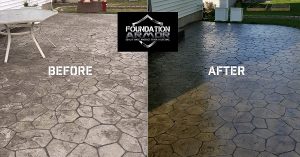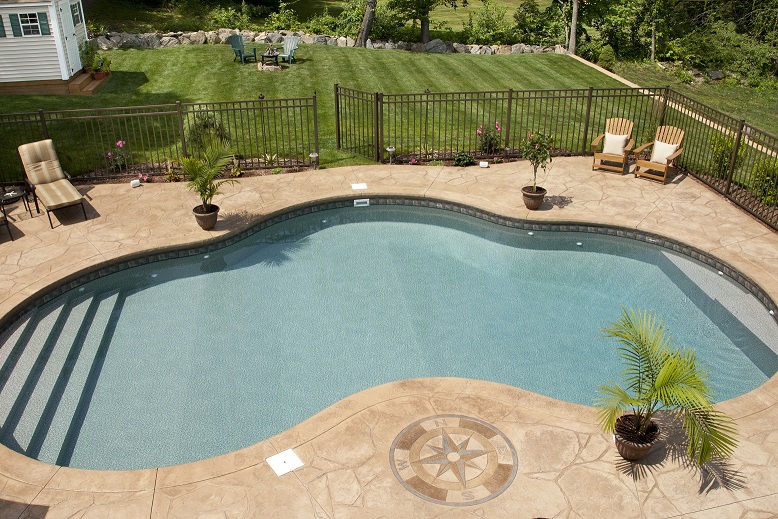Types of Stamped Concrete Sealers
In general, there are three types of concrete sealers that can be used to seal stamped concrete: Silicate sealers, silane siloxane sealers, and acrylic sealers. If the three types of concrete sealers, acrylic concrete sealers are the best type of sealer to use on stamped concrete.
Silicate and silane siloxane sealers are penetrating sealers that work below the surface of the concrete. Silicate sealers are rarely used on stamped concrete because crystals can form on the surface when the silicate reacts with the stamped concrete. Silane siloxane sealers can be used, but the problem with silane siloxane sealers is that they don’t change the look or color of the concrete, and they don’t leave behind a protective surface film. If you have colored stamped concrete, a siliane siloxane sealer will not prevent the color from fading. The only way to protective the color of the stamped concrete is to seal it with an acrylic sealer.
Acrylic concrete sealers will leave behind a protective surface film that not only protects the su rface from deterioration, but also protects the color from fading. Color will fade from surface abrasion and exposure to UV rays, and acrylic sealers will stop that from happening. In many cases, an acrylic sealer will actually enhance the color of the concrete to bring a more consistent finish to the entire surface.
rface from deterioration, but also protects the color from fading. Color will fade from surface abrasion and exposure to UV rays, and acrylic sealers will stop that from happening. In many cases, an acrylic sealer will actually enhance the color of the concrete to bring a more consistent finish to the entire surface.
The photo on the right was taken from FoundationArmor.com. It very accurately shows how well a good solvent based acrylic sealer can enhance and protect a stamped concrete surface.
There are a few different types of acrylic sealers. There are water based acrylics, solvent based acrylics, acrylic lacquer sealers, and acrylic co-polymer sealers.
- Water vs Solvent Based Acrylic Sealers: There are a few differences between water and solvent based acrylic sealers. Water based acrylic sealers typically won’t darken the surface of the stamped concrete, but solvent based acrylic sealers will darken the surface. Solvent based acrylic sealers are often used to achieve a wet look, and to bring out any dull and faded coloring in the stamped concrete. Next, you have maintenance. When it comes time to repair or re-coat a water based acrylic sealer, typically you need to screen scuff the entire surface. Solvent based acrylic sealers don’t require screen sanding. Solvent based acrylic sealers can easily be repaired with Xylene, and when it comes time to re-coat you simply put more down. Solvent based acrylic sealers are the most popular type of acrylic sealer for this reason.
- Acrylic Lacquer Sealers vs Acrylic Co-polymer Sealers: Acrylic lacquer sealers are commonly used on cured concrete and acrylic co-polymers, because they contain styrene, are used on uncured concrete. Acrylic lacquer sealers offer an aggressive bond to stamped concrete, but acrylic co-polymers are not as sensitive to moisture. There aren’t enough differences between the two to make one better than the other.
Stamped Concrete Sealer Reviews
Concrete sealer reviews are a great place to start to compare stamped concrete sealers, but they aren’t the only thing to consider.
Water Based Acrylic Sealer Reviews:
- Seal-Krete Clear Seal Acrylic Sealer (average 4 star review)
- Armor WB25 Acrylic Sealer (average 4.9 star review)
Solvent Based Acrylic Sealer Reviews:
- Eagle High Gloss Sealer (average 4.6 star review)
- Armor AR350 Wet Look Sealer (average 4.8 star review)
- Armor AR500 High Gloss Sealer (average 4.9 star review)
- Enduraseal SB Acrylic Sealer (average 4.5 star review)
Best Acrylic Cure and Seals:
- Armor LV25 (average 5 star review)
- Quikrete Cure and Seal (average 4.6 star review)
As mentioned above, there are a few factors to consider when choosing a stamped concrete sealer.
- You always want to consider reviews, but they shouldn’t always be the determining factor. Acrylic sealers are very sensitive to application and if applied outside of those parameters, can result in premature failure. Even the best products have a few bad reviews.
- Reach out to the manufacturer yourself. Do they have good customer service? Are they available through phone, chat, and email? Do they know their stuff, or are they just trying to sell you something? You have one experience with the product, but the company is who you will have a relationship with. You want to make sure they are looking out for your best interest and are truly concerned with your issue.
- Where are the products made? This is actually a very large determining factor of life and performance. U.S. manufactured products made from non-recycled resins can last up to 2 years longer than a product made from imported or recycled resins. Recycled resins sounds good, but they really aren’t when it comes to acrylic sealers. The chemicals used in the recycling process are often left in the sealer. Additives are added to the acrylic sealers to counter the chemicals left, but the chemicals can’t be completely removed. The chemicals in the sealer will cause both the sealer and the additives to break down. For this reason, many sealers using imported or recycled resins will last anywhere from two months to a year.
How to Seal Stamped Concrete
There are a few different ways in which you can seal stamped concrete. How you seal the stamped concrete will depend on the type of concrete sealer being used, and whether or not the stamped concrete is currently sealed.
Regardless of the type of sealer used, there are a few things you want to consider:
- Stamped concrete should be thoroughly cleaned. Many types of cleaners will leave behind a surface residue. If a residue is left on the surface it will prevent the sealer from being able to properly penetrate and bond. If you think a residue is on the surface, give the stamped concrete another rinse until the cleaner has been completely removed.
- Allow the stamped concrete to dry completely. While the surface of the stamped concrete may look dry, water still resides in the pores. If a pressure washer was used, or if the stamped concrete is around a pool, it should be allowed to dry for at least 24 hours.
If your concrete is currently unsealed, or if the sealer has been completely removed, then you can proceed with applying the sealer as directed by the manufacturer.
If your concrete is currently sealed and you are simply trying to re-coat, you need to make sure the new sealer is compatible with the old. Water based acrylic concrete sealers need to be re-coated with water based acrylic sealers, and solvent based acrylic sealers need to be re-coated with solvent based acrylic sealers. If you attempt to put a water based acrylic over a solvent based acrylic, or a solvent based acrylic over a water based, then the solvent in the solvent based acrylic will attack the water based acrylic and result in coating failure. If you wish to switch from a water based to a solvent based, all of the water based acrylic must be removed first.

